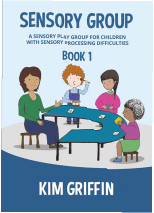As an occupational therapist (OT) I have used the five senses in therapy sessions to enhance children’s language development and understanding. Here are some of the ways the senses can be incorporated into daily life activities.
Learning language by DOING
Every action our body makes relies on our senses. Jumping relies on our vision, balance (vestibular) sense and our sense of body awareness (proprioception). Writing relies heavily on our touch, vision, and proprioceptive senses. It also requires our balance sense to help to keep us sitting upright. Talking wouldn’t happen if we couldn’t feel the movements our tongue and lips make and would be wasted if the listener couldn’t hear what was being said. I would encourage you to include the physical action as much as possible when helping children to learn their verbs. Movement songs are another way to help to reinforce verbs. Doing the action with a physical item can also help, for example with drawing or cutting.
DESCRIBING using your senses
Sensory activities easily lend themselves to help with understanding adjectives. If you are painting, the paint might be sticky, dry, or runny – describe the colours you see. Adapt the texture or add scents or glitter to change the qualities of play dough. All of these sensory characteristics provide excellent opportunities for exploring adjectives with children. In addition, if the child is working on particular adjectives (e.g. hot and cold), match sensory items (e.g. ice and a heat pack) to demonstrate and reinforce these.
Extremes of Senses – Sometimes children need to experience how something feels in order to be able to adjust their behaviour. This is particularly true if they are being too fast or too loud or too hard. It can be useful to explore very fast, very slow and somewhere in the middle with in order for them to understand what you mean when you ask them to slow down. Explore volume with their voice, whistles and instruments so they understand what volume you are expecting them to use in different situations. If children are being too forceful it can help to squeeze, push, pull, throw items with a lot of force (hard) and then a small amount of force (gentle) to help them to make the links between the language adults are using and their own bodies.
Sensory PREPOSITIONS
For children who are learning prepositions such as ‘in’, ‘on’ and ‘under’ with their speech therapist, we have seen faster progress when these terms are used within their OT sessions. Tunnels, especially material ones, are a fantastic resource to help children to understand basic positional differences. E.g. Ask a child to go under the tunnel, on the tunnel and in the tunnel. Using movement with an object is a really clear way to reinforce the difference between the meanings of the different prepositions. The playground is also a brilliant space to practise these concepts. Using whole body movement really helps the children to understand the differences between prepositions. Once the child understands the terms in relation to their own body, you can start to use them in relation to their peers, toys or other objects.
Sensory language opportunities in the classroom
In the classroom and at home messy sensory play lends itself to so many language opportunities – e.g. pasta; you can stir the pasta or sprinkle the pasta, you can talk about the texture and the noise raw pasta makes when dropped into a pan. Homemade playdough is great to squeeze, squash, push and roll. Messy play is a fun way to explore language concepts and can also be used to encourage joint attention. Adults supporting the child can vocalise what is happening e.g., ‘John is putting his hands under the pasta,’ or ‘Look everyone, Suzie is squashing the playdough.’
Including sensory descriptions in your language doesn’t need to stop with sensory play. There are many opportunities during a child’s day where these can be included. When getting dressed you can describe the movements, e.g. pushing or pulling, opening and closing how fabric feels and how the clothes look. Meal times provide so many chances to talk about tastes, smells, colours, textures and temperatures. This includes snack time at school, especially with fruit. Peeling fruit provides great opportunities for using verbs. Or, if the adult is cutting up fruit, they can describe what they are doing as they go. Smells and flavours can be described. Textures and sounds can be discussed: “Is it crunchy?”, or “Does it make a noise when you bite into it?”
In Conclusion
Using the senses can be an engaging way to help children to explore language concepts. This includes verbs, adjectives and prepositions. My challenge to you is to use children’s senses to explore and expand on their language daily.
If you are looking for a sensory play option for children who avoid messy play, Sensory Group Book 1 is a useful resource. This structured classroom programme is designed to support children with sensory sensitivities, such as those who avoid messy textures, dislike getting their hands dirty and/or dislike noises. It is also a good sensory based option for children who demonstrate poor joint attention and turn taking. It is suitable for children with diagnosis such as autism, Down’s Syndrome or learning disabilities with a cognitive age of three to five years.
Sensory Group Book 1 contains twelve different sensory lists that can be run in 12-24 sessions. Additional resources include visuals of the sensory item and the action to support language development.
As a special offer for Speech Link readers Griffin OT is offering a 10% discount and free delivery on any purchases of Sensory Group made in the month of (June). Please go to www.griffinot.com/SLJune.

Sensory Group Book 1Kim Griffin is a paediatric occupational therapist. Her company GriffinOT delivers affordable online sensory training and motor skill development programmes to schools, teachers and parents. For more information visit https://www.GriffinOT.com/SL
Cover photo courtesy of Sharon McCutcheon from Pexels.
Please login to view this content
Login